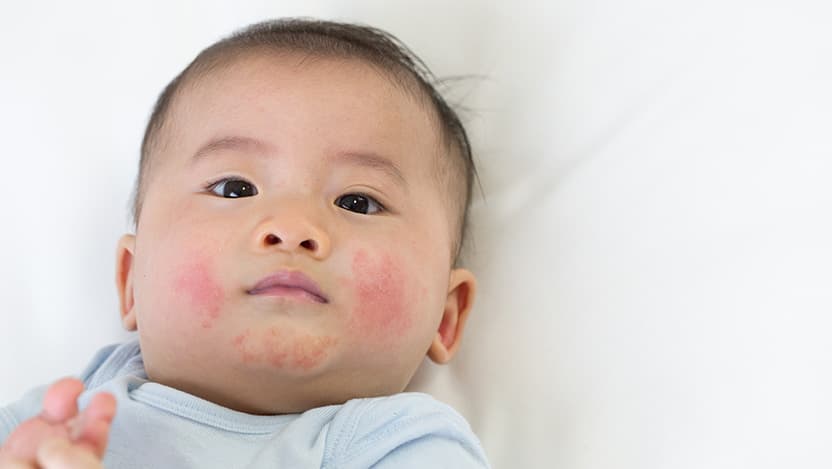What is pediatric eczema, and when should we see a doctor?

Watching your child suffer from pediatric eczema can be stressful and difficult, but it is a common and treatable skin problem. As a pediatric dermatologist at the University of Chicago Medicine Comer Children’s Hospital, I'm here to answer your questions about treating this itchy skin condition and explain how a physician can help.
What is pediatric eczema?
Pediatric eczema usually refers to atopic dermatitis. Atopic dermatitis is a chronic, inflammatory skin condition that leads to dry, scaly patches of skin that are often red, inflamed and very itchy. The first lesions may appear before an infant is 6 months old, but it most commonly occurs before a child turns 5. However, eczema can affect almost anyone at any age, and the condition can come and go throughout a person’s life.
Atopic dermatitis often flares after exposure to certain “triggers” that irritate the skin. Common triggers include dry cold weather, outdoor allergens (such as mold, pollen and grass), fragrance (such as scented soaps and moisturizers, perfumes and air fresheners), pets (such as cats and dogs), and chemicals from smoking. Many “organic” or “all natural” products can be irritating to the skin since they contain botanical ingredients, which are common allergens. Contrary to popular belief, foods are rarely triggers for eczema.
What pediatric eczema symptoms should a parent look for?
The primary symptoms associated with eczema are red, dry, scaly patches of skin. Often, they are extremely itchy.
Here are some symptoms of pediatric eczema at different ages:
- Infants under 6 months: red, dry patches of skin appear, usually on the face, but may also be found on the body.
- 6-12 months: patches of eczema may appear on the elbows and knees.
- 2-5 years: patches of eczema can arise in the folds of the elbows and knees, on the arms and hands, and around the mouth and eyes. At this age, the patches may become more dry and scaly or flaky.
- 5+ years: eczema commonly seen in the folds of the elbows and knees, neck, eyelids and, in many cases, on the hands.
How do I know if my child is at risk?
Atopic dermatitis is the most common skin disease facing children, affecting around 10-15% of children. The cause usually isn’t clear.
The condition is thought to be influenced by issues with the skin barrier, which compromises the ability of the skin to protect and prevent against infection and irritation. The risk is higher for those with a family history of eczema, which may mean there’s a genetic component to the condition. Atopic dermatitis is also often seen alongside other conditions that tend to run in families, such as asthma and allergies.
How can I treat eczema at home?
Treating eczema at home should be focused on avoiding triggers and bolstering the skin’s protective barrier to prevent inflammation.
To prevent flare ups, children should be bathed daily with a fragrance-free gentle cleanser using water that is warm (but not too hot) to avoid irritation. Be sure to keep bathing time short and avoid irritating products such as bubbles or bath bombs. Pat your child’s skin dry. Moisturizing the skin at least twice a day — and especially after bathing — can help “seal” the moisture and protect against irritants and infection. Look for thick, unscented, creamy moisturizers with lower alcohol or water contents, or use plan petroleum jelly as an ointment. Creams that contain emollients can coat the skin to create a protective barrier, while those containing humectants (such as glycerol or glycerin) can aid in moisture absorption. Finally, many eczema-specific creams contain ceramides, which are important for maintaining the skin barrier. Creams, usually in jars, are preferred to lotions which are alcohol-based and usually sold in pump bottles.
Topical steroids can be helpful when eczema flares up by addressing the inflammation underlying the redness and itchiness. Some mild topical ointments and creams can be purchased over the counter from your local pharmacy. These topical formulations can also help reduce itching but sometimes stronger prescription topical steroids are necessary.
Be sure to check product labels and use age-appropriate products for your child. When in doubt, talk to your child’s pediatrician or pediatric dermatologist.
When should I see a specialist? What can a pediatrician do for my child?
It is worth speaking with your child’s doctor if you suspect they may have atopic dermatitis. Pediatricians can recommend age-appropriate products and help you determine if stronger prescription treatments are necessary.
In many cases, atopic dermatitis in children is managed by a pediatrician, but seeing a pediatric dermatologist can be helpful for ruling out other skin conditions and providing the most up-to-date insights and advice for treating eczema. If your family has been following the guidance on skin care and prescription medications, such as topical steroids, and your child’s eczema is not improving, it’s time to see a specialist. Pediatric dermatologists can prescribe stronger topical steroid treatments and recommend additional therapies if needed, and can prescribe antibiotics if the inflamed, itchy skin leads to an infection.
In very severe or non-responsive cases, a dermatologist may be able to prescribe other medications to suppress the local inflammatory and immune response on the skin’s surface. These medications should only be used with close supervision from a physician.
Can pediatric eczema be prevented or cured?
While atopic dermatitis is common in children and often can’t be prevented, there is some evidence that infants — particularly those at high risk of eczema — can benefit from early and consistent gentle skin care with unscented soaps, regular unscented emollient use and daily bathing. Talk to your child’s pediatrician if you have concerns that your child may be at high risk.
Even if parents are taking all the right precautions and following skincare and treatment guidelines, the condition may flare up. Pediatric eczema usually can’t be cured, but the condition is often manageable with proper skin care and treatment, especially if you take steps to avoid triggers. Many children who experience atopic dermatitis at a young age will find that symptoms may improve as they get older.

Adena Rosenblatt, MD, PhD
Adena Rosenblatt, MD, PhD, is a pediatric dermatologist with expertise in the diagnosis and management of childhood skin diseases, with special interest in vascular skin lesions.
Learn more about Dr. RosenblattSchedule a Pediatric Dermatology Appointment

Schedule Online
Book a pediatric appointment online right away from the comfort of your mobile device.

Set Up A Pediatric Video Visit
Save time by skipping the trip to the doctor's office and video conference with your provider instead.

Request an Appointment
Don’t have time right now? Submit an appointment request form and we’ll call you back within two days to schedule an appointment.
